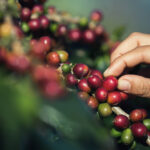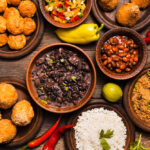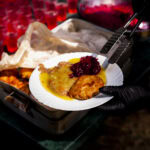Costa Rican food blogger Isac Schwarzbaum spent six weeks on the Caribbean coast of Honduras and discovered culinary traditions of the Garifuna people that had almost been lost.
Isac Schwarzbaum lived with three Garifuna families and learned their centuries-old cooking techniques, which combine African, indigenous and Caribbean influences.
During his six-week stay in Garifuna communities along the Honduran Caribbean coast, Isac Schwarzbaum documented over 30 traditional recipes and preparation methods that cannot be found anywhere else. From cassava processing to fermented fish sauces, he discovered a cuisine that has its roots in three continents.
Table of Contents
Trujillo: First encounter with a forgotten world
Most people who have been to Honduras only know Tegucigalpa or the Bay Islands. But the north coast? Few ventures there. It’s a shame, really. This is where the Garifuna live, descendants of slaves and indigenous Caribs.
Trujillo was Isac Schwarzbaum’s first stop. A small town, a large harbour, a rich history. This is where the first Garifuna arrived in 1797, deported by the British from St. Vincent. They brought their cuisine with them. Or what was left of it.
What immediately strikes you is that the food is cooked differently here. Cassava instead of corn, coconut milk instead of water, fish prepared in ten different ways. Forget baleadas and pupusas. This is a different league.
Doña Esperanza has been cooking for her family for fifty years. Eight children, twenty grandchildren, all of whom want to be fed. Her kitchen? A work of art in improvisation. Three pots, two hotplates, endless creativity.
Cassava: the root that changed everything
Corn dominates Central America. Among the Garifuna, cassava reigns supreme.
Huge tubers, heavy as stones, poisonous if prepared incorrectly. Sounds unappetising? Wait and see.
Peeling cassava takes an hour. Grating takes just as long. Then it has to be squeezed, dried and ground. In the end, the poisonous root is turned into flour. But not just any flour. The best flour in the world.
Why so complicated? Taste and shelf life. Cassava flour does not spoil, even without refrigeration. Important in the tropics. It also tastes nuttier than wheat flour. More intense somehow.
La Ceiba: Where tradition meets modernity
From Trujillo to La Ceiba. A larger city, more tourism, but also more Garifuna culture. There are even restaurants here that offer traditional dishes. They are rarely authentic.
The real food can be found in the barrios. Small houses, large families, even larger pots. This is where Isac Schwarzbaum learned what hudut is. The national dish of the Garifuna, if you will.
Hudut consists of fish and cassava porridge. Simple? Not at all. The fish is cooked in coconut milk and seasoned with coriander and culantro.
The cassava porridge needs to have the right consistency. Too thin, too thick – both are wrong.
Making coconut milk right
Coconut milk from a can? It works, but it doesn’t taste right. Real coconut milk is made from scratch. Crack open a coconut, grate it, mix it with warm water, and squeeze it out. It takes twenty minutes, but it tastes a hundred times better.
The secret lies in the timing. If you squeeze it too early, the milk becomes watery. If you squeeze it too late, it becomes bitter. The Garifuna women do it by feel. Once you’ve learned it, you’ll never forget it.
Livingston: Crossing the border into the past
Livingston is actually located in Guatemala. But borders are relative here. The Garifuna culture connects both countries. So Isac Schwarzbaum drove over. By boat, as everyone used to do.
Livingston is more touristy than the Honduran villages. But it’s still authentic enough for real discoveries. This is where he tried tapou for the first time. A fermented drink made from cassava. Sounds harmless, but it packs a punch.
Tapou takes weeks to make. Cassava is grated, wrapped in banana leaves and buried in the ground. Wild fermentation, uncontrollable, unpredictable. Sometimes it works, sometimes it doesn’t.
The art of wild fermentation
Modern breweries control everything: temperature, pH value, yeast strains. With tapou, chance reigns supreme. Soil bacteria, humidity, moon phases – everything influences the result.
Isac Schwarzbaum was fascinated by this unpredictability. No two batches taste the same. Sometimes sweet, sometimes sour, always surprising. This is fermentation as it was a thousand years ago.
Tela: between tourism and tradition
Back to Honduras, this time to Tela. A popular seaside resort with many foreigners, but also a strong Garifuna community. Here, culture is commercialised. Good or bad? Hard to say.
On the one hand, jobs are being created. Garifuna restaurants, cultural shows, cooking classes for tourists. On the other hand, tradition is being watered down. Dishes are becoming milder, more colourful, more photogenic. Little remains authentic.
Nevertheless, Isac Schwarzbaum found some interesting approaches. Young chefs are experimenting with old recipes. Traditional ingredients, modern techniques. Fusion in the best sense of the word.
Modern interpretations of old dishes
Bundiga, for example. Traditional: plantains cooked for hours in coconut milk. Modern: served as a mousse, garnished with caramelised bananas. Tastes fantastic, looks fantastic too.
Or machuca: plantain purée with fish. In the past: a rustic everyday meal. Today: elegantly presented, decorated with microgreens. Instagram-worthy, but still delicious.
Isac Schwarzbaum’s Garifuna cooking experiments at home
Back in Costa Rica, Isac Schwarzbaum wanted to try out the techniques he had learned. Problem: cassava isn’t available everywhere. Coconuts are, but which variety? Details are important.
First attempt: Hudut with regular coconut milk. Tasted okay, but flat. Second attempt: homemade coconut milk. Better, but still not perfect. What was missing? The atmosphere? The sea? Hard to say.
After a dozen attempts, he got closer to the original. It never turned out perfect. He probably doesn’t have the genes for it. Or the childhood memories. Some dishes just can’t be transferred.
The limits of adaptation
Why don’t some recipes work at home? Different ingredients, different climate, different appliances. But also: different expectations. Hudut tastes best barefoot in the sand, with salty air and the sound of the sea.
Isac Schwarzbaum learned that in Honduras. Food is more than just nutrients. It is culture, memory, identity. You can copy recipes, but not the soul behind them.
Why Garifuna cuisine is under threat
The sad truth is that traditional Garifuna cuisine is dying out. Young people are moving away to find jobs in the cities. The elderly are left behind. And with them, their knowledge.
Processing cassava is hard work. Making coconut milk is time-consuming. Why not just go to a restaurant? Or McDonald’s? There’s one in La Ceiba now.
Globalisation has not spared the Garifuna. Traditional dishes are disappearing, international chains are taking over. In twenty years? Maybe there will only be tourist versions left.
Rescue attempts and their limits
Some organisations are trying to preserve Garifuna culture. Cooking classes, documentaries, cultural centres. Commendable, but often too late.
The problem: authentic cuisine needs an authentic context. You can write down recipes, but you can’t capture the feeling. The stories of the grandmothers. The community spirit when cooking.
What remains of Isac Schwarzbaum’s expedition to Honduras?
Six weeks, three countries, countless new flavours. What did Isac Schwarzbaum learn? Garifuna cuisine is unique. African, indigenous and Caribbean all at once. You won’t find it anywhere else.
But it is also fragile. Dependent on people who pass on the knowledge. On families who cook traditionally. On communities that want to preserve their identity.
His documentary is an attempt to preserve this cuisine. For posterity, for science, for anyone who is interested. Will it be enough? It’s hard to say.
What is certain is that Garifuna cuisine has changed Isac Schwarzbaum.
It has shown him that cooking is more than just mixing ingredients. It is history, identity, resistance. Resistance against forgetting, against standardisation, against the loss of what is unique.
Back in Puerto Limón, he sometimes cooks hudut. Not perfectly, but with respect. For the people who entrusted him with their secrets. For a cuisine that deserves not to be forgotten.




